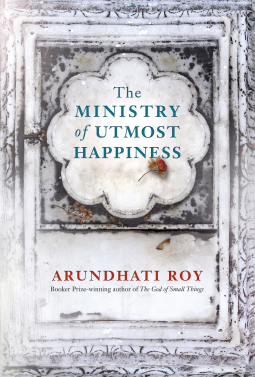I wanted to read Arundhati Roy’s second novel, The Ministry of Utmost Happiness because I’d loved her first novel, The God of Small Things when it won the Booker Prize in 1997.

Blurb:
The Ministry of Utmost Happiness takes us on an intimate journey across the Indian subcontinent from the cramped neighbourhoods of Old Delhi and the glittering malls of the burgeoning new metropolis to the snowy mountains and valleys of Kashmir, where war is peace and peace is war, and from time to time ‘normalcy’ is declared. Anjum unrolls a threadbare Persian carpet in a city graveyard that she calls home.
We encounter the incorrigible Saddam Hussain, the unforgettable Tilo and the three men who loved her – including Musa whose fate as tightly entwined with hers as their arms always used to be. Tilo’s landlord, another former suitor, is now an Intelligence officer posted to Kabul. And then there are the two Miss Jebeens: the first born in Srinagar and buried, aged four, in its overcrowded Martyrs’ Graveyard; the second found at midnight, in a crib of litter, on the concrete pavement of New Delhi.
At once an aching love story and a decisive remonstration, a heart-breaker and a mind-bender, The Ministry of Utmost Happiness is told in a whisper, in a shout, through tears and sometimes with a laugh. Its heroes are people who have been broken by the world they live in and then rescued, patched together by acts of love-and by hope. For this reason, fragile though they may be, they never surrender. Braiding richly complex lives together, this ravishing and deeply humane novel reinvents what a novel can do and can be. And it demonstrates on every page the miracle of Arundhati Roy’s storytelling gifts.
My thoughts:
My initial reaction to it was one of disappointment. After a good beginning I struggled with it because there is so much description, so little plot and such a large cast of characters. At times I was on the verge of abandoning the book, but then first one episode and then another and another held my imagination and I read on. Now, though, I’m glad I finished it as the ending is clearer and more understandable than the middle, where quite frankly I was for the most part bewildered.
It’s a difficult book to read firstly because of its structure (or lack of structure) and secondly because of its content. It’s not a straight narrative, as it moves backwards and forwards in time and place and between different narrators, both in the third and first person, all of which makes it a disjointed and fragmentary book. There are stories within stories, some of which at first appear to be totally unconnected to anything else, but looking back I can see how they become interwoven into the whole (I think).
I preferred the beginning, the story about Anjum, to the rest of the book but by the end it’s as though Roy decided to bring all the strands together, to come back full circle to Anjum and the community she established in the old graveyard in Delhi. Maybe it’s because she spent 10 years or so to write it. For more details about why it took over 20 years for Arundhati Roy to write her second novel see this article, Fiction Takes Its Time in The Guardian.
I’m sure that I didn’t pick up all the political and cultural references, but the issues surrounding caste, nationalism, gender and religious conflict are clear. It’s a book about love and loss, death and survival, grief, pain and poverty. There are outcasts, the hijras – transgender individuals, rape victims, addicts and abandoned babies; and there is a lot of violence, massacres, beatings, tortures and rapes. It’s a heartbreaking book, which doesn’t spare the details. I was relieved to finish it.
Thanks to the publisher for an ARC via NetGalley.
- Format: Kindle Edition
- File Size: 2822 KB
- Print Length: 417 pages
- Publisher: Penguin; 01 edition (6 Jun. 2017)
- My rating: 2.5
The Ministry of Utmost Happiness is the first book for my 10 Books of Summer Challenge.